Acid-Extracted Hydrocarbon Anomalies and Significance in the Chaoshan Depression of the Northern South China Sea
Abstract
:1. Introduction
2. Geological Setting
3. Sampling and Methods
4. Results
4.1. Acid-Extracted Hydrocarbon Composition
4.2. Acid-Extracted Hydrocarbon Distribution
4.3. δ 13C (‰) of Acid-Extracted Hydrocarbon Methane
5. Discussion
5.1. Variations in Acid-Extracted Hydrocarbon Abundance
5.2. Acid-Extracted Hydrocarbon Structural Indicators
5.3. The Fabric Characteristics of Hydrocarbons
5.4. Differentiation Characteristics of Hydrocarbon
5.5. Carbon Isotope of Methane (δ13C) Features
5.6. Evaluation of Favorable Oil and Gas Areas
6. Conclusions
- The oil and gas reservoir in the Chaoshan Depression is mainly composed of condensate gas (oil). The reservoir is of an organic thermal origin. The source rock is dominated by marine sedimentation, with highly mature organic matter.
- The favorable oil and gas prospects in the Chaoshan Depression are divided into two regions, respectively favorable zone I and favorable zone II, mainly located at the intersection of the central low bulge, the western depression, and the western slope of the depression; the DS-A structure indicates an oil and gas reservoir dominated by gas.
- The “lower generation, upper accumulation and micro fractures leaking” model is the mechanism explaining the formation of oil and gas anomalies in the Chaoshan Depression, in which hydrocarbons are controlled by the underlying petroleum reservoir, leak through micro-fractures, and adsorb on the seabed’s surface.
Author Contributions
Funding
Institutional Review Board Statement
Informed Consent Statement
Data Availability Statement
Acknowledgments
Conflicts of Interest
References
- Shao, L.; You, H.; Hao, H.; Wu, G.; Qiao, P.; Lei, Y. Petrology and depositional environments of Mesozoic strata in the Northeastern South China Sea. Geol. Rev. 2007, 53, 164–169. Available online: https://en.cnki.com.cn/Article_en/CJFDTOTAL-DZLP200702004.htm (accessed on 5 March 2022).
- Hao, H.; Shi, H.; Zhang, X.; Wang, T.; Tang, S. Mesozoic sediments and their petroleum geology conditions in Chaoshan sag: A discussion based on drilling results from the exploratory well LF35-1-1. China Offshore Oil Gas 2009, 21, 151–156. Available online: https://en.cnki.com.cn/Article_en/CJFDTOTAL-ZHSD200903001.htm (accessed on 5 May 2020).
- Zhang, L.; Geng, A.; Wang, L.; Liao, Y.; Xu, G.; Wei, Z. Assessment of Mesozoic source rocks at the Margin of South China Continent. Mar. Geol. Quat. Geol. 2012, 32, 99–108. [Google Scholar] [CrossRef]
- Yang, S.; Tong, Z.; He, Q.; Hao, J. Mesozoic hydrocarbon generation history and igneous intrusion impacts in Chaoshan depression. South China Sea: A case of LF35-1-1 well. China Offshore Oil Gas 2008, 20, 152–156, (In Chinese with English abstract). [Google Scholar]
- Hu, T.; Wu, G.; Xu, Z.; Pang, X.; Liu, Y.; Yu, S. Potential resources of conventional, tight, and shale oil and gas from Paleogene Wenchang Formation source rocks in the Huizhou Depression. Adv. Geo-Energy Res. 2022, 6, 402–414. [Google Scholar] [CrossRef]
- Guo, H.; Wang, Z.; Wang, B.; Zhang, Y.; Meng, H.; Sui, H. Molecular dynamics simulations of oil recovery from dolomite slit nanopores enhanced by CO2 and N2 injection. Adv. Geo-Energy Res. 2022, 6, 306–313. [Google Scholar] [CrossRef]
- Yang, Z.; Zou, C.; Gu, Z.; Yang, F.; Li, J.; Wang, X. Geological characteristics and main challenges of onshore deep oil and gas development in China. Adv. Geo-Energy Res. 2022, 6, 264–266. [Google Scholar] [CrossRef]
- Hao, H.; Wang, R.; Zhang, X.; Xie, H.; Chen, Z. Mesozoic marine sediment identification and distribution in the eastern Pearl River Mouth Basin. China Offshore Oil Gas 2004, 16, 84–88. [Google Scholar]
- Duan, J.; Mi, H. Seismic facies and sedimentary facies study of Mesozoic in Chaoshan sag. Resour. Ind. 2012, 14, 100–105, (In Chinese with English abstract). [Google Scholar]
- Yan, P.; Wang, Y.; Jin, Y.; Zhao, M.; Zhong, G. Deep-water coral of multiple benthal strategies discovered from mounds in the Dongsha Waters in the South China Sea. Earth Sci. Front. 2021, 29, 202–210. [Google Scholar] [CrossRef]
- Zhang, Q.; Zhang, H.; Zhang, X. The upper Cretaceous prototype basin of the Chaoshan depression in the northern South China Sea and its tectonic setting. Chin. J. Geophys. 2018, 61, 4308–4321. [Google Scholar] [CrossRef]
- Wang, P.; Xia, K.; Huang, C. The Mesozoic Marine sediment distribution and Geology-Geophysics characteristic at the North-Eastern of South China Continent. J. Trop. Oceanogr. 2000, 19, 28–35. [Google Scholar]
- Wu, N.; Zhang, G.; Liang, J.; Su, Z.; Wu, D.; Lu, H. Progress of gas hydrates research in northern South China Sea. Adv. New Renew. Energy 2013, 1, 80–94. [Google Scholar]
- Brown, A. Evaluation of possible gas micro seepage mechanisms. AAPG Bull. 2000, 84, 1775–1789. [Google Scholar] [CrossRef]
- Ramkumar, M.; Nagarajan, R.; Santosh, M. Advances in sediment geochemistry and chemostratigraphy for reservoir characterization. Energy Geosci. 2021, 2, 308–326. [Google Scholar] [CrossRef]
- Decker, J.; Teas, P.; Orange, D.; Bernard, B.B. Sea bottom characteristics and geochemistry of oil and gas seeps in the Gulf of Mexico. Interpretation 2022, 10, SB49–SB62. [Google Scholar] [CrossRef]
- Zavatsky, M.D.; Veduta, O.V.; Naumenko, V.O. Prospecting terrain for surface geochemical exploration of oil and gas in West Siberia. Geol. Ecol. Landsc. 2022. [Google Scholar] [CrossRef]
- Rice, G.K. Vertical migration in theory and in practice. Interpretation 2021, 10, SB17–SB26. [Google Scholar] [CrossRef]
- Jatiault, R.; Loncke, L.; Dhont, D.; Imbert, P.; Dubucq, D. Geophysical characterization of active thermogenic oil seeps in the salt province of the lower Congo basin. Part II: A regional validation. Mar. Pet. Geol. 2019, 103, 773–791. [Google Scholar] [CrossRef]
- Hosseinpour, M. Relationship between hydrocarbon micro-seepages and structures by detection of altered minerals using ASTER remote sensing data in the West of Coastal Fars, Zagros, Iran. Arab. J. Geosci. 2020, 13, 511. [Google Scholar] [CrossRef]
- Cameron, N.; White, K. Surface geochemical exploration continues to progress global Deepwater Frontiers. In Proceedings of the IBC “Worldwide Deepwater Technologies” Forum, London, UK, 11–12 April 2000; pp. 11–12. Available online: https://www.tdi-bi.com/wp-content/uploads/2017/01/SGE-Progresses-DW-Frontiers.pdf (accessed on 23 May 2024).
- Belt, J.Q., Jr.; Rice, G.K. Application of statistical quality control measures for near—Surface geochemical petroleum exploration. Comput. Geosci. 2002, 28, 243–260. [Google Scholar] [CrossRef]
- Kumar, B.; Patil, D.J.; Kalpana, G.; Vishnu Vardhan, C. Geochemical prospecting of hydrocarbons in Frontier basins of India. In Proceedings of the American Associa-tion of Petroleum Geologists Annual Convention, AAPG, Dallas, TX, USA, 18–21 April 2004; pp. 18–21. Available online: https://www.semanticscholar.org/paper/Geochemical-Prospecting-of-Hydrocarbons-in-Frontier-Kumar-Kalpana/884ab57ad958193c280683b2d9485f5e4747cd9d (accessed on 23 May 2024).
- Abrams, M.A. Significance of hydrocarbon seepage relative to petroleum generation and entrapment. Mar. Pet. Geol. 2005, 22, 457–477. [Google Scholar] [CrossRef]
- Hovland, M.; Jensen, S.; Fichler, C. Methane and minor oil macro-seep systems—Their complexity and environmental significance. Mar. Geol. 2012, 332–334, 163–173. [Google Scholar] [CrossRef]
- Al-Areeq, N.M.; Maky, A. Organic geochemical characteristics of crude oils and oil-source rock correlation in the Sunah oilfield, Masila Region, Eastern Yemen. Mar. Pet. Geol. 2015, 63, 17–27. [Google Scholar] [CrossRef]
- Bougi, M.S.M.; Baklouti, S.; Rasheed, M.A.; Pls, R.; Hasan, S.Z.; Ksibi, M.; Gharbi, J. Integrated geo-microbial and trace metal anomalies for recognition of hydrocarbon microseepage in petroliferous regions: Case of El Hajeb oilfield in the South East of Tunisia. Pet. Sci. Technol. 2018, 36, 2029–2036. [Google Scholar] [CrossRef]
- Anderson, J.; Romanak, K.; Alfi, M.; Hovorka, S. Light hydrocarbon and noble gas migration as an analogue for potential CO2 leakage: Numerical simulations and field data from three hydrocarbon systems. Greenh. Gases Sci. Technol. 2019, 9, 226–244. [Google Scholar] [CrossRef]
- Abrams, M.A. Evaluation of near-surface gases in marine sediments to assess subsurface petroleum gas generation and entrapment. Geoscience 2017, 7, 35. [Google Scholar] [CrossRef]
- Horvitz, L. Hydrocarbon prospecting after forty years. In Unconventional Exploration for Petroleum and Natural Gas II; Gottlieb, B.M., Ed.; Southern Methodist University Press: Dallas, TX, USA, 1981; pp. 83–95. [Google Scholar]
- Horvitz, L. Geochemical exploration for petroleum. Science 1985, 229, 812–827. [Google Scholar] [CrossRef]
- Whiticar, M.J. Characterization and Application of Sorbed Gas by Microdesorption CF-IRMS. In Proceedings of the Near-Surface Hydrocarbon Migration: Mechanisms and Seepage Rates, American Association Petroleum Geology Hedberg Conference, Vancouver, BC, Canada, 7–10 April 2002. [Google Scholar]
- Su, P.; Liang, J.; Zhang, W.; Liu, F.; Wang, F.; Li, T. Natural gas hydrate accumulation system in the Shenhu sea area of the northern South China Sea. Nat. Gas Ind. 2020, 40, 77–88. [Google Scholar] [CrossRef]
- Zhang, J.; Sun, Z.; Zhang, S. Analysis of Mesozoic tectonic deformation in the Chaoshan Depression of Pearl River Mouth Basin. J. Trop. Oceanogr. 2014, 33, 41–49. Available online: http://www.jto.ac.cn/EN/lexeme/showArticleByLexeme.do?articleID=578 (accessed on 5 March 2021).
- Ye, Q.; Mei, L.; Shi, H. The Late Cretaceous tectonic evolution of the South China Sea area: An overview, and new perspectives from 3D seismic reflection data. Earth-Sci. Rev. 2018, 187, 186–204. [Google Scholar] [CrossRef]
- Hao, H.; Zhao, J.; Liu, H. Prediction of oil and gas reservoir traps by aromatic hydrocarbons from seabed sediments in Chaoshan depression, South China Sea. Acta Pet. Sin. 2018, 39, 528–540. [Google Scholar] [CrossRef]
- Zhou, D.; Wang, W.; Wang, J. Mesozoic subduction-accretion zone in northeastern South China Sea inferred from geophysical interpretations. Sciences China Earth, zone in northeastern South China Sea inferred. Sci. China Earth 2006, 49, 471–482. [Google Scholar] [CrossRef]
- Yan, Y.; Liao, J.; Yu, J.; Chang, L.; Guangjian, Z.; Yanlin, W. Velocity Structure Revealing a Likely Mud Volcano off the Dongsha Island, the Northern South China Sea. Energies 2022, 15, 195. [Google Scholar] [CrossRef]
- Blumenberg, M.; Lutz, R.; Schlömer, S.; Krüger, M.; Scheeder, G.; Berglar, K.; Heyde, I.; Weniger, P. Hydrocarbons from near-surface sediments of the Barents Sea north of Svalbard—Indication of subsurface hydrocarbon generation? Mar. Pet. Geol. Bull. 2016, 76, 432–444. [Google Scholar] [CrossRef]
- Abrams, M.A. Geophysical and geochemical evidence for subsurface hydrocarbon leakage in the Bering Sea, Alaska. Mar. Pet. Geol. Bull. 1992, 9, 208–221. [Google Scholar] [CrossRef]
- Abrams, M.A. Distribution of subsurface hydrocarbon seepage in near-surface marine sediments. In Hydrocarbon Migration and Its Near Surface Effects; American Association Petroleum Geology Memoir No. 66; Schumacher, D., Abrams, M.A., Eds.; American Association of Petroleum Geologists: Tulsa, OK, USA, 1996; Chapter 1; pp. 1–14. [Google Scholar]
- Abrams, M.A. Marine seepage variability and its impact on evaluating the surface migrated hydrocarbon seep signal. Mar. Pet. Geol. 2020, 121, 104600. [Google Scholar] [CrossRef]
- Klusman, R.W.; Saeed, M.A. A comparison of light hydrocarbon micoseepage mechanisms. In Hydrocarbon Migration and Its Near Surface Effects; Schumacher, D., Arams, M.A., Eds.; American Association of Petroleum Geologist Memoil: Tulsa, OK, USA, 1996; Volume 66, pp. 157–168. [Google Scholar]
- Dai, J.; Fei, X.; Qi, H. China Gas-Geology; Petroleum Industry Press: Tulsa, OK, USA, 1992. [Google Scholar]
- Zhao, J.; Liang, Q.; Zhang, L.; Zhong, G. Oil and gas reservoir attribute discrimination based on surface sediment acid-extraction hydrocarbon in the western depression of Taiwan Strait Basin. Geophys. Geochem. Explor. 2018, 42, 436–441. [Google Scholar] [CrossRef]
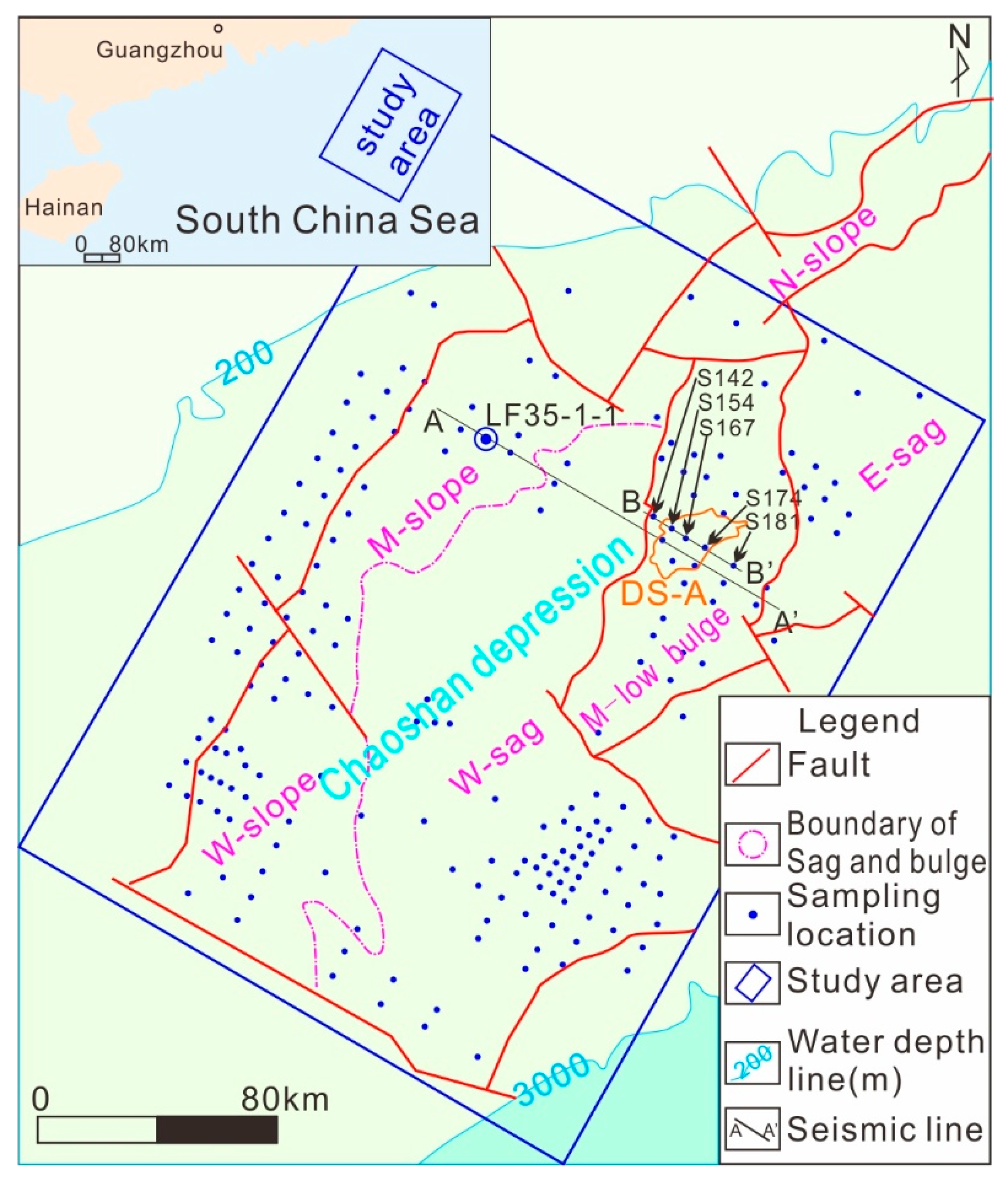
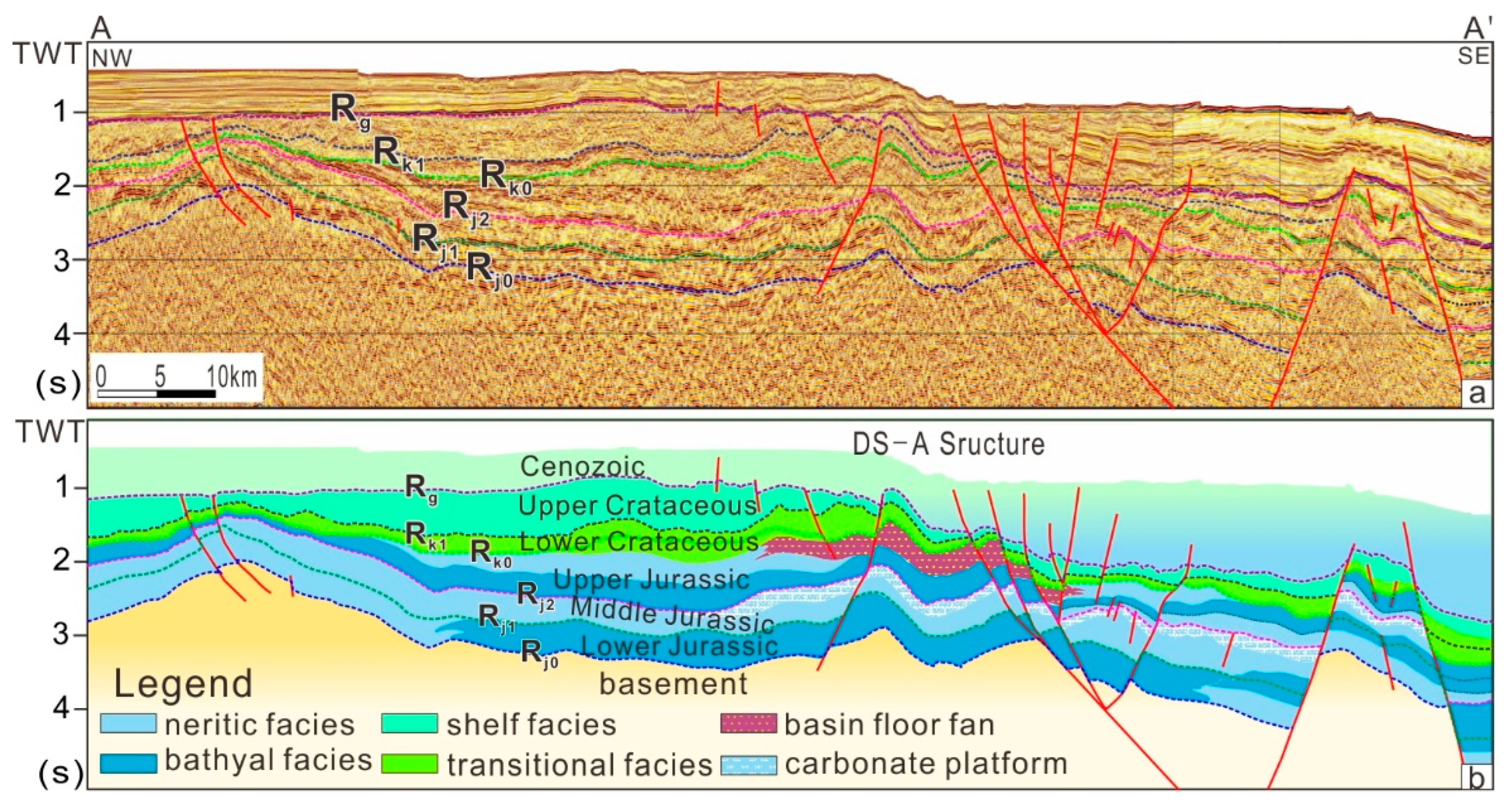


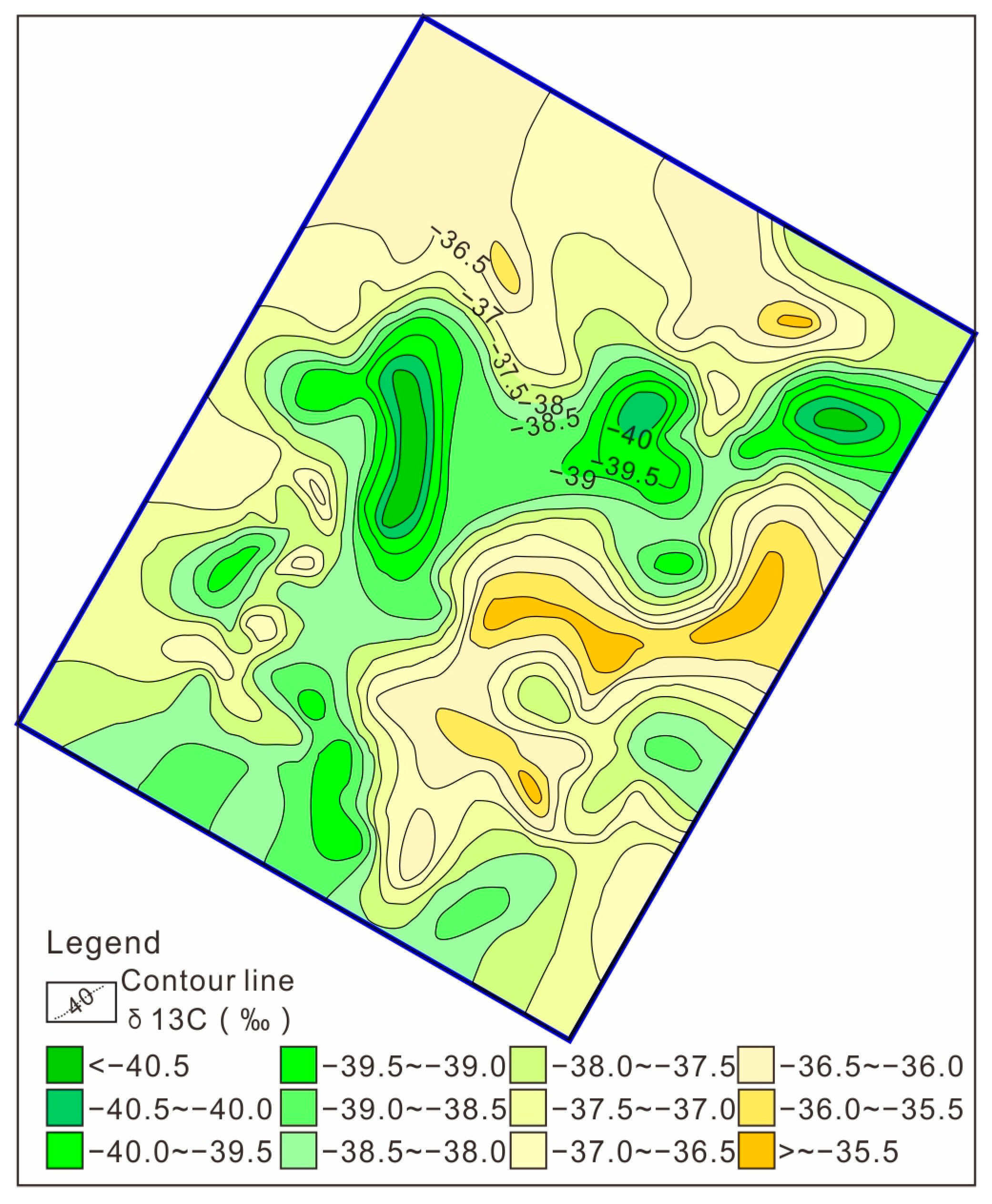
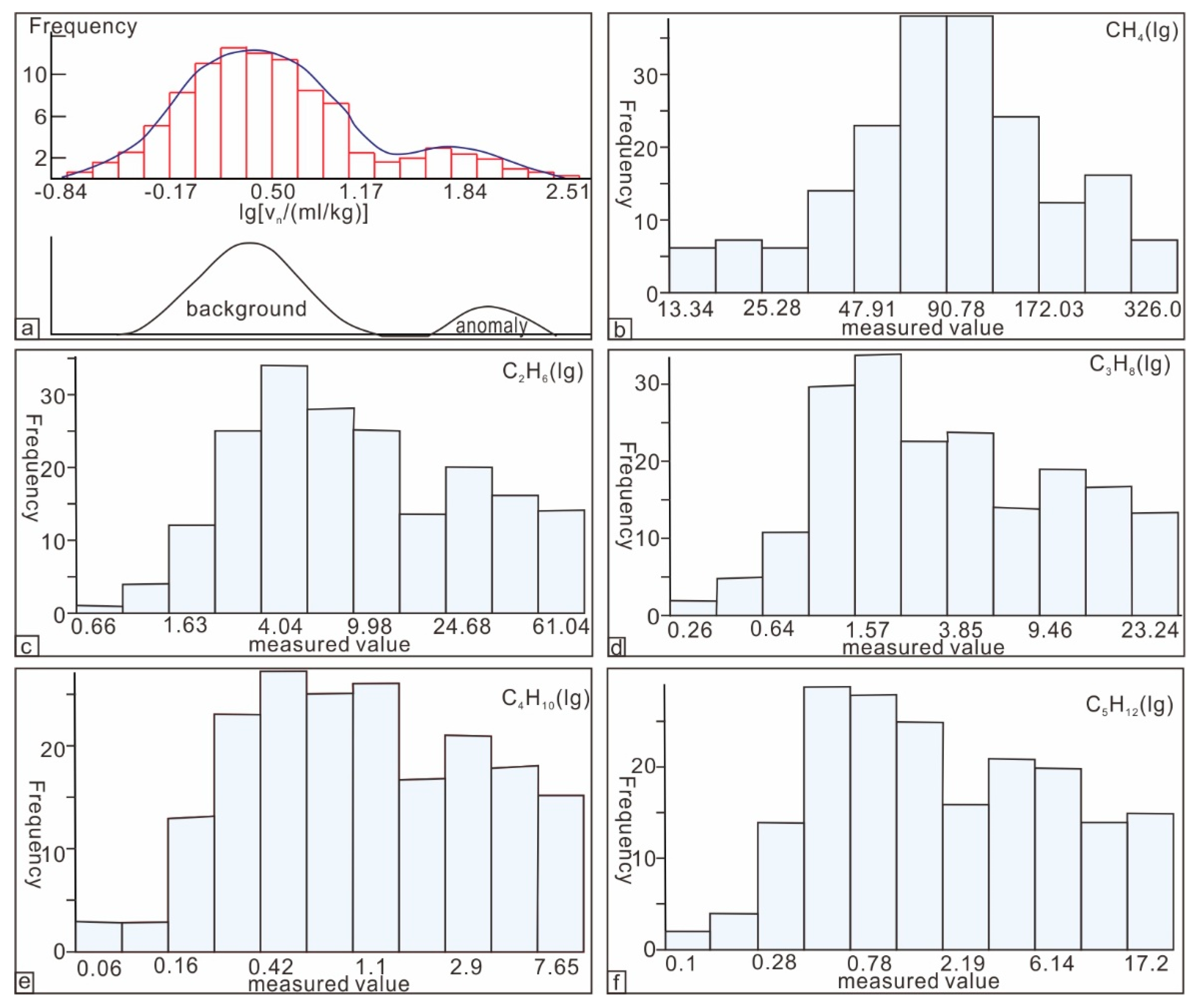
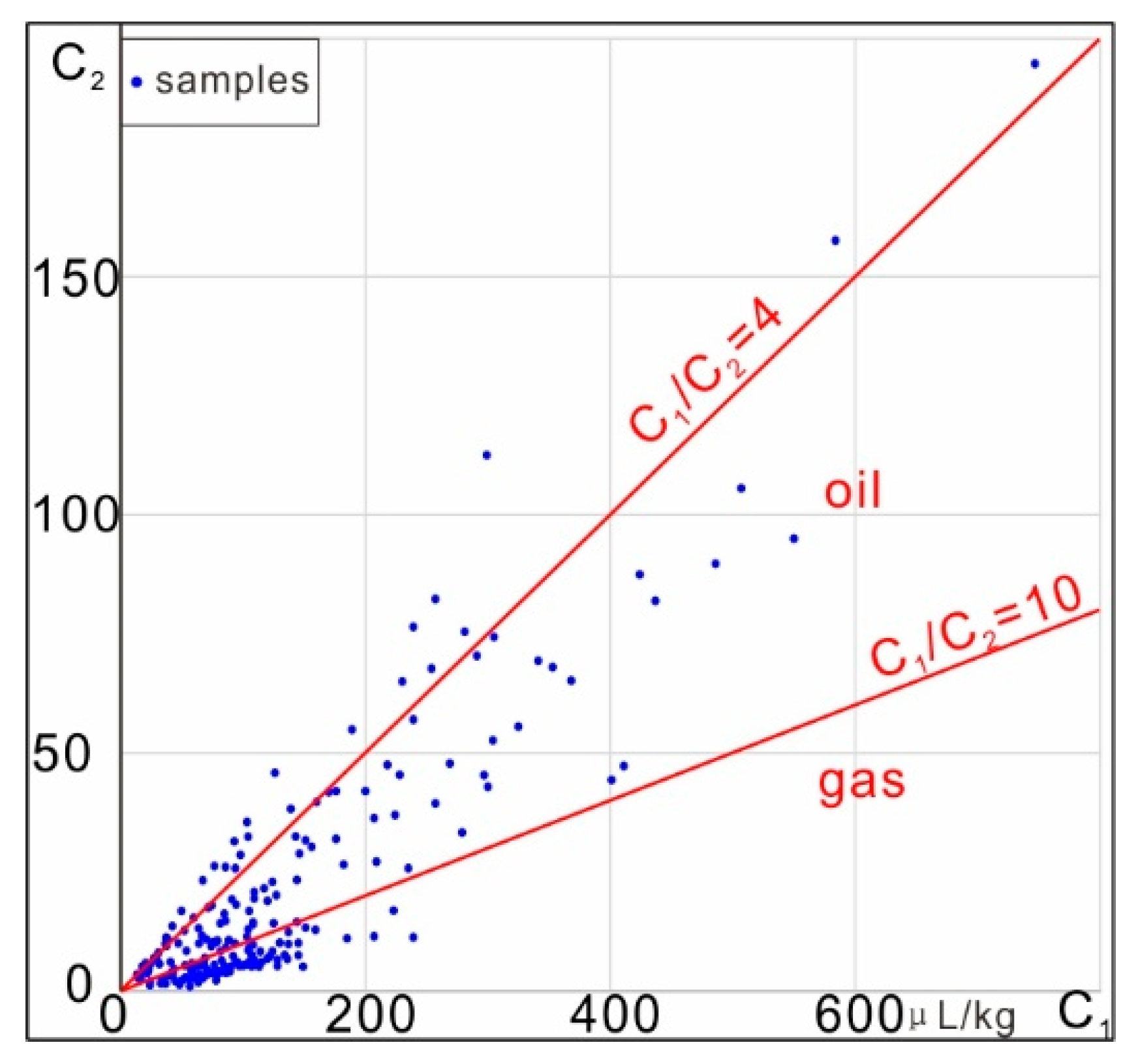
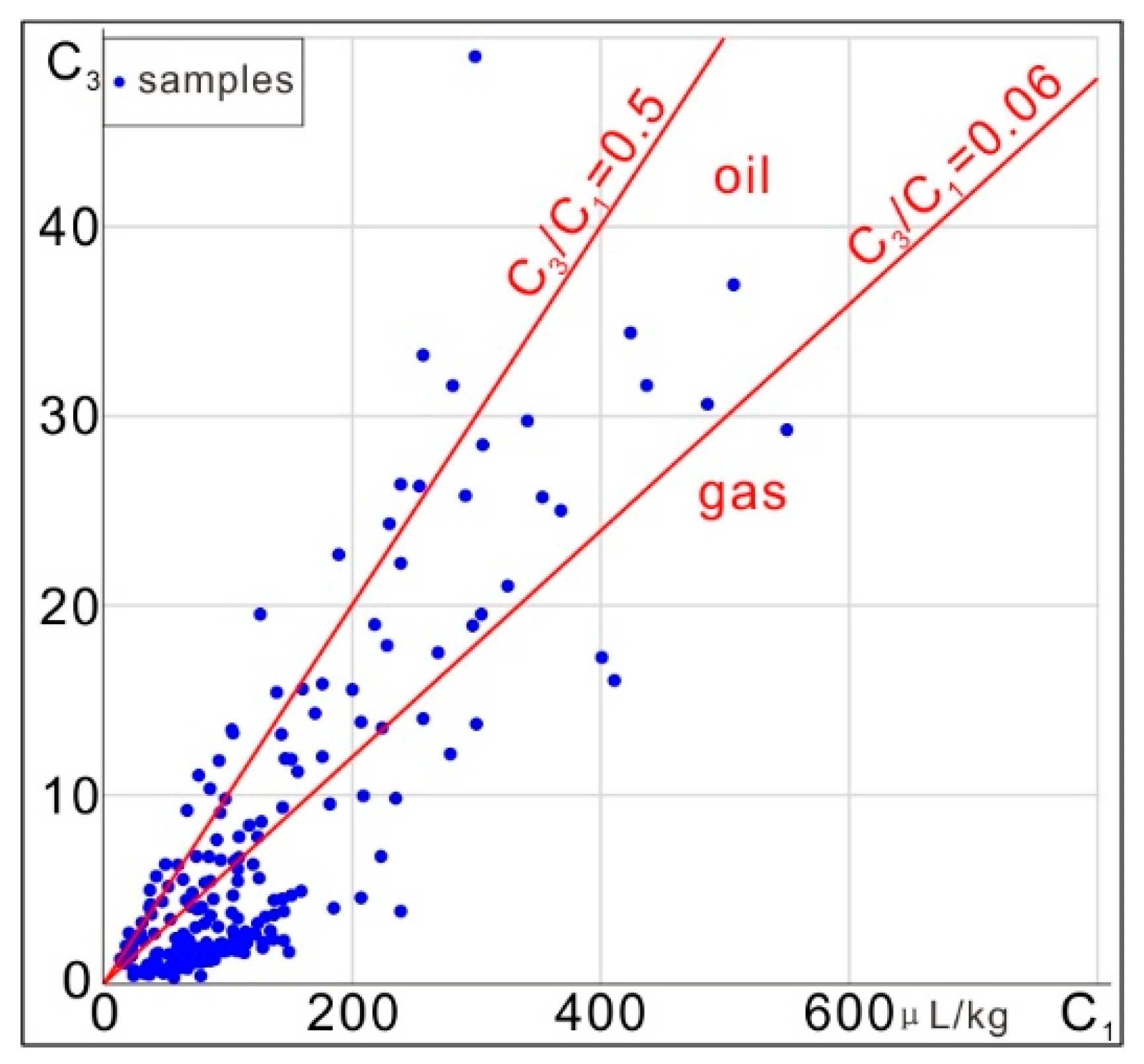
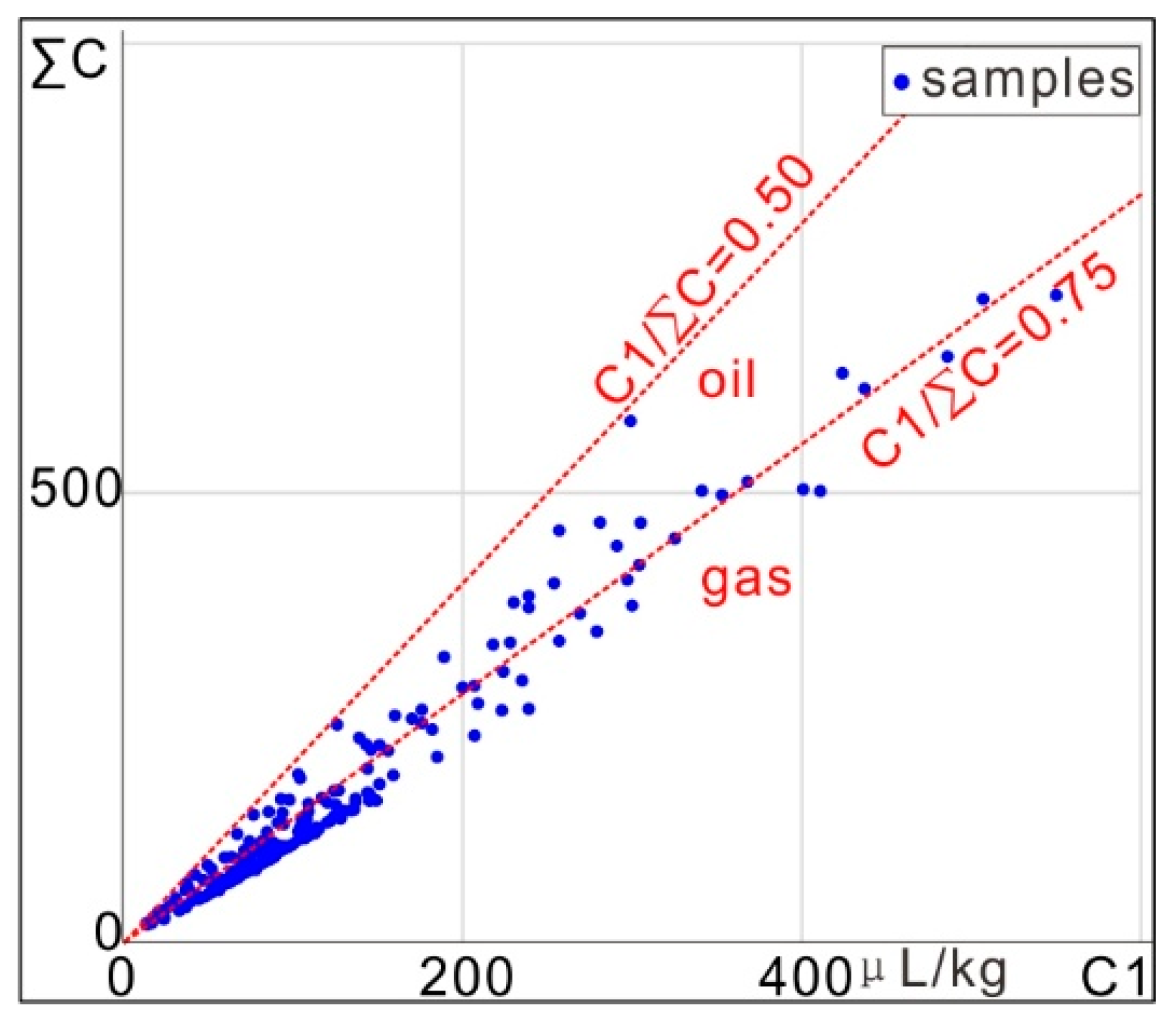
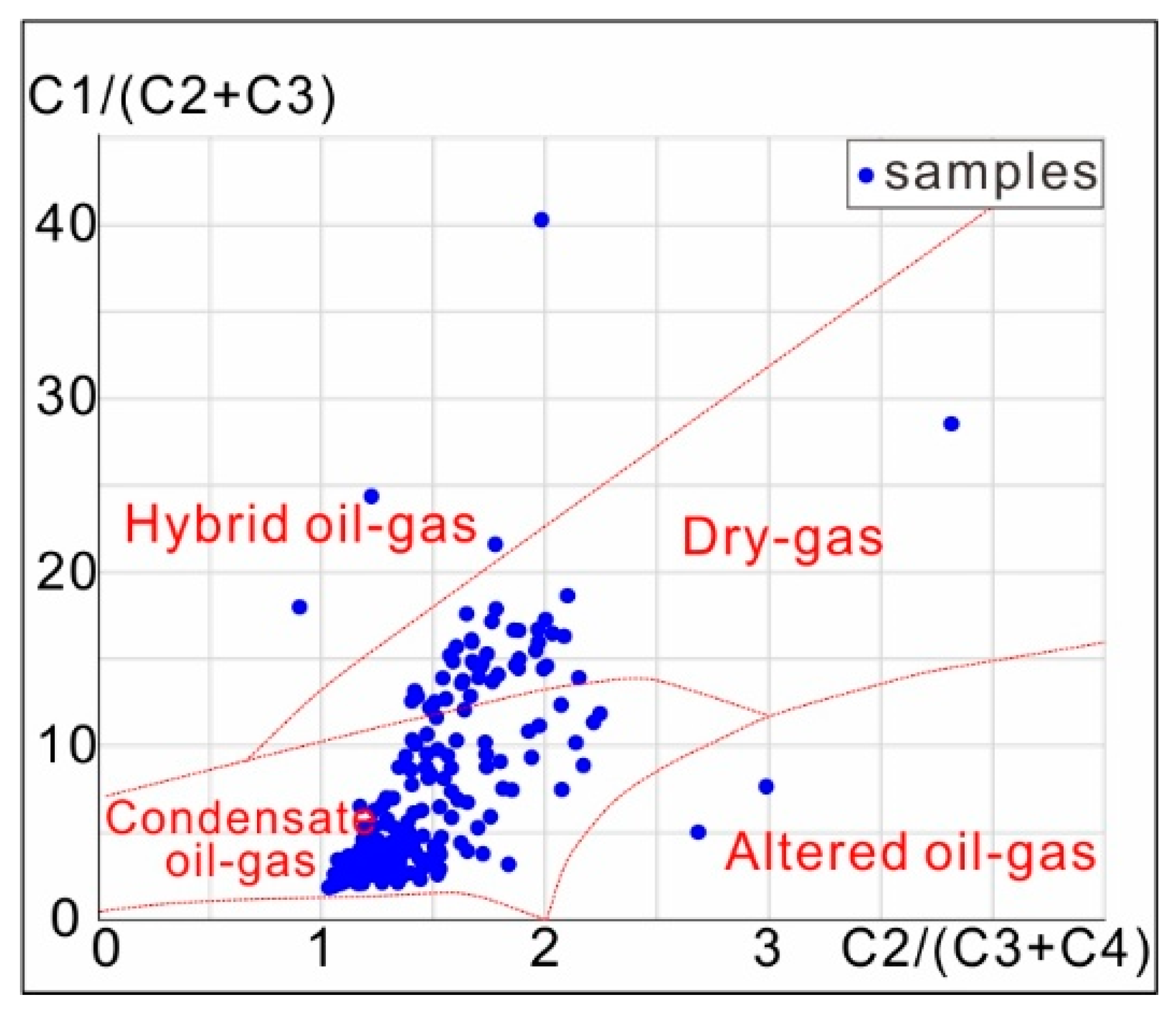
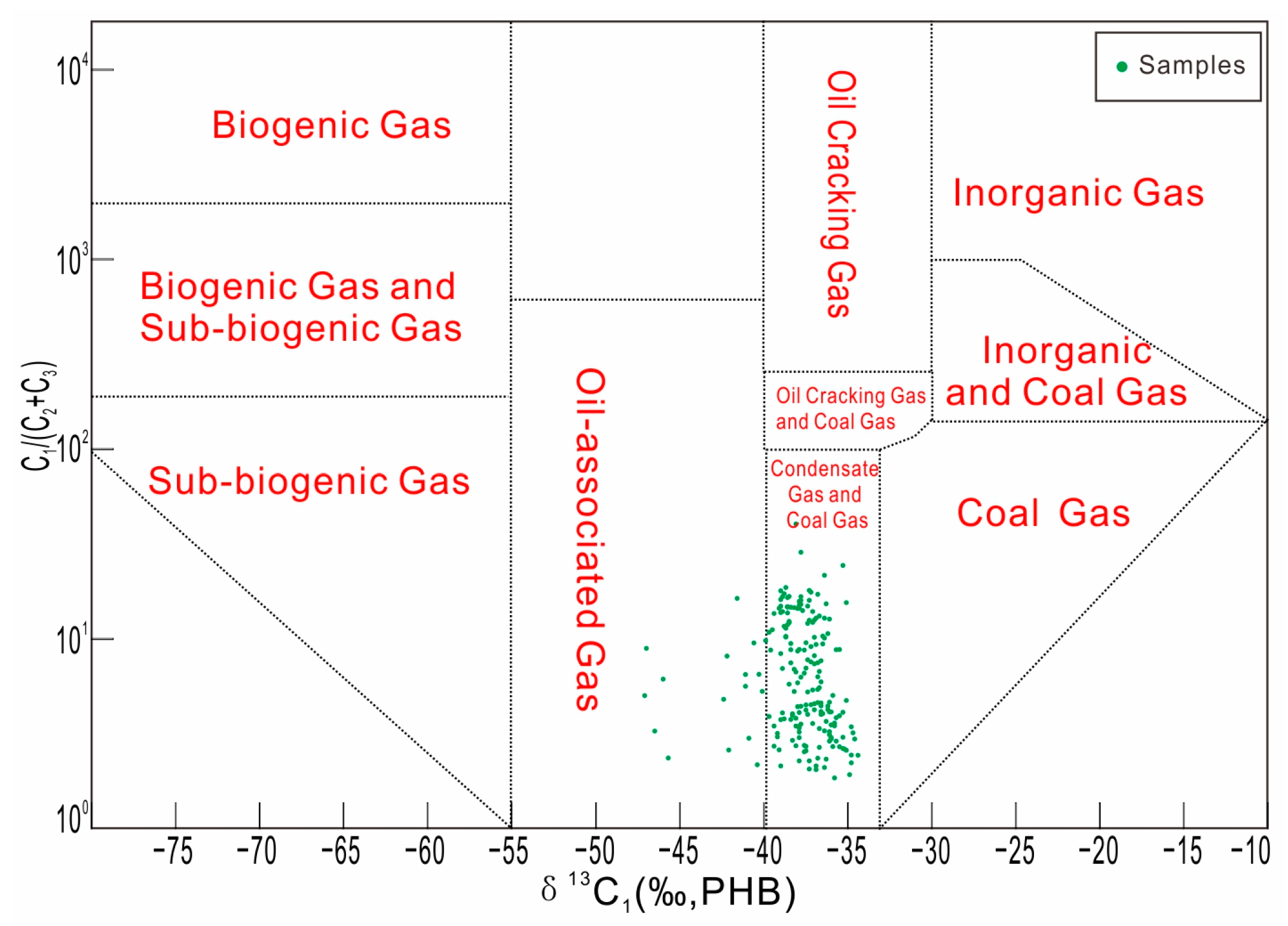
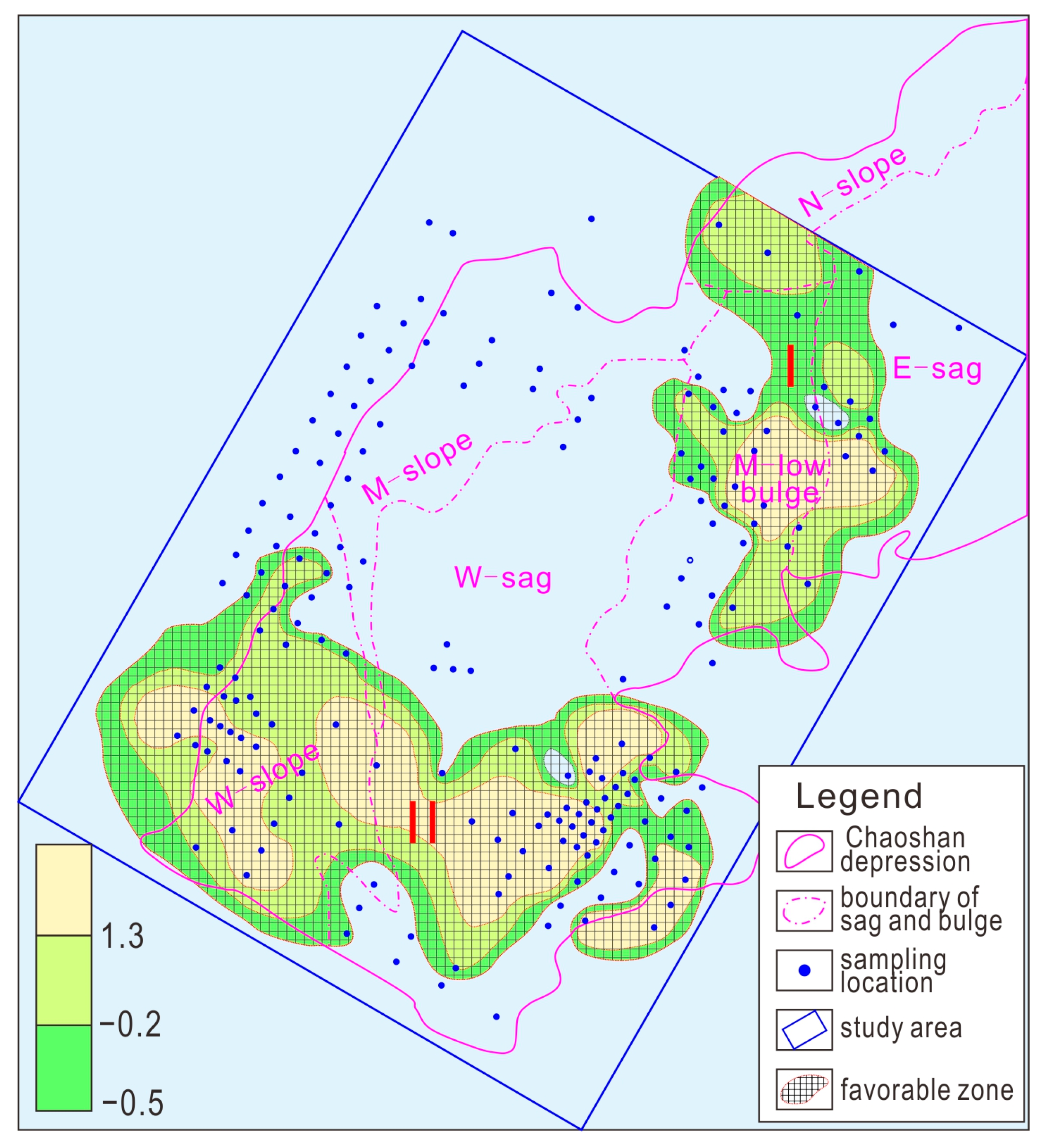

| Minimum (μL/kg) | Maximum (μL/kg) | Median (μL/kg) | Mean (μL/kg) | SD | CV | K | |
|---|---|---|---|---|---|---|---|
| SC1 | 13.34 | 1799.31 | 94.01 | 138.25 | 163.23 | 1.18 | 1.47 |
| SC2 | 0.66 | 195.26 | 9.54 | 21.61 | 29.99 | 1.39 | 2.27 |
| SC3 | 0.26 | 80.64 | 3.57 | 8.17 | 11.79 | 1.44 | 2.29 |
| SiC4 | 0.10 | 67.37 | 2.14 | 5.97 | 9.61 | 1.61 | 2.80 |
| SnC4 | 0.06 | 32.53 | 1.25 | 2.89 | 4.37 | 1.51 | 2.32 |
| SiC5 | 0.02 | 87.15 | 2.47 | 7.38 | 12.29 | 1.66 | 2.99 |
| SnC5 | 0.01 | 9.74 | 0.22 | 0.53 | 0.99 | 1.87 | 2.47 |
| SC2g | 1.23 | 465.18 | 19.74 | 46.56 | 68.47 | 1.47 | 2.36 |
| Type | Ratio of Hydrocarbon | ||
|---|---|---|---|
| C1/∑C × 100 | C1/C2 | (C3/C1) × 1000 | |
| Oil | 75~50 | 10~4 | 60~500 |
| Gas | >75 | >10 | <60 |
Disclaimer/Publisher’s Note: The statements, opinions and data contained in all publications are solely those of the individual author(s) and contributor(s) and not of MDPI and/or the editor(s). MDPI and/or the editor(s) disclaim responsibility for any injury to people or property resulting from any ideas, methods, instructions or products referred to in the content. |
© 2024 by the authors. Licensee MDPI, Basel, Switzerland. This article is an open access article distributed under the terms and conditions of the Creative Commons Attribution (CC BY) license (https://creativecommons.org/licenses/by/4.0/).
Share and Cite
Zhong, G.; Zhao, J.; Zhao, Z.; Zhang, K.; Yu, J.; Shang, C.; Tu, G.; Feng, C. Acid-Extracted Hydrocarbon Anomalies and Significance in the Chaoshan Depression of the Northern South China Sea. J. Mar. Sci. Eng. 2024, 12, 909. https://doi.org/10.3390/jmse12060909
Zhong G, Zhao J, Zhao Z, Zhang K, Yu J, Shang C, Tu G, Feng C. Acid-Extracted Hydrocarbon Anomalies and Significance in the Chaoshan Depression of the Northern South China Sea. Journal of Marine Science and Engineering. 2024; 12(6):909. https://doi.org/10.3390/jmse12060909
Chicago/Turabian StyleZhong, Guangjian, Jing Zhao, Zhongquan Zhao, Kangshou Zhang, Junhui Yu, Chunjiang Shang, Guanghong Tu, and Changmao Feng. 2024. "Acid-Extracted Hydrocarbon Anomalies and Significance in the Chaoshan Depression of the Northern South China Sea" Journal of Marine Science and Engineering 12, no. 6: 909. https://doi.org/10.3390/jmse12060909






